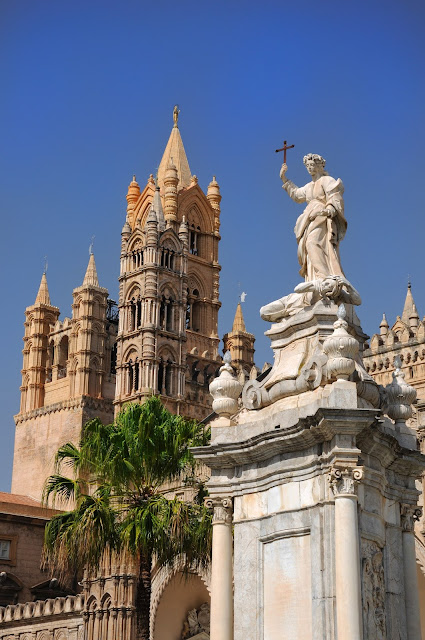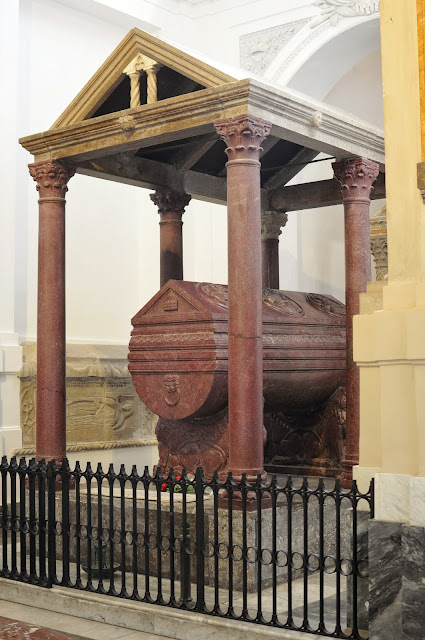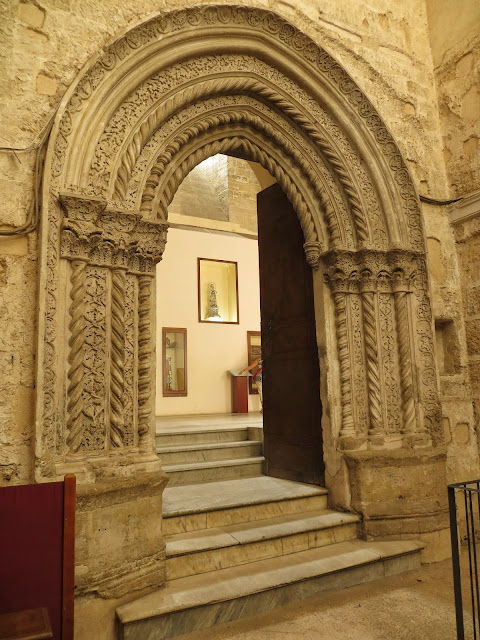C’è un momento, quando ripenso a Palermo, che non dimenticherò mai e che riaffiora tutte le volte
che si nomina questa città: quando vidi per la prima volta la Cattedrale di Maria SS. Assunta. La
gente intorno a me accalcata nella via, decisamente troppo stretta per tutte
quelle persone, e all’improvviso la visuale si apre. Non c’è tempo per tirare
un sospiro di sollievo per lo spazio ritrovato, perché lo spettacolo che si
pone davanti lo toglie di nuovo. Sembra un’oasi, che trasporta in un luogo sospeso tra Oriente e Occidente,
al cospetto di uno dei gioielli di Palermo.
È una descrizione strana per un
cattedrale, eh? Ma è proprio quella sensazione che non potrò mai dimenticare,
perché non ti aspetti quella vista. Arriva all’improvviso. Se poi sei a Palermo
in estate, la luce accecante del sole e la calura ti fanno davvero sentire ne Le mille e una notte.
La parte antistante è sostanzialmente un parco sulla quale si
posa lo sguardo benevolo di Santa
Rosalia, la patrona della città, che la guarda da una colonna nel bel mezzo
del piazzale. Non viene subito voglia di entrare nella cattedrale, non perché
non sia attraente, ma perché la visita inizia fuori! C’è così tanto da vedere e
così tanti dettagli da ammirare, che ti dimentichi che c’è anche l’interno da
visitare. Ti spiego meglio.
L’esterno della cattedrale, come ti ho già detto, ti mostra
un edificio asimmetrico che mescola il gusto occidentale con quello orientale,
per cui trovi elementi tradizionali della nostra architettura e altri meno,
come per esempio le piccole cupole. Il fatto, poi, che sorga dove nel 1184
c’era una moschea a me ha dato ulteriormente l’impressione di essere sospesa
tra due culture. Come buona parte degli edifici religiosi di una certa
dimensione e importanza, anche questo ha subito nel tempo modifiche e
adeguamenti. E qui veniamo a elementi che sono più familiari ai canoni
occidentali. Infatti, la facciata orientale è originale, ma quella occidentale
è gotica e il portico a tre arcate da cui si accede è gotico - catalano.
Insomma, puoi vedere il passare del tempo e delle tendenze artistiche e
architettoniche sulle mura della cattedrale.
Dopo aver fatto il pieno di bellezza e ricchezza con
l’esterno della cattedrale, è ora di entrare. Un’altra sorpresa mi attende
varcata la soglia. Mi sarei aspettata che l’interno rispecchiasse la ricchezza
dell’esterno e invece no. È ugualmente prezioso, ma più sobrio, solenne. Entrare nelle
chiese mi mette sempre un po’ a disagio:
tutta quella grandezza intorno a me mi fa sentire ancora più piccola di quanto
non sia, e inizio a girare guardandomi intorno col naso all’insù. E qui invece
il naso deve stare anche giù! Dopo aver guardato in alto, bisogna guardare in
basso per non perdersi lo spettacolo che è la
meridiana “a camera oscura”. Una linea di marmo e ottone lunga 21 metri
corre lungo il pavimento; ai lati si trovano i segni zodiacali. Quando al luce
a mezzogiorno (dell’ora solare) entra dal buco sulla volta, detta gnomone,
questa indicherà in quale segno zodiacale ci si trova. E funziona!
Girare nella cattedrale è straniante: ci sono così tante cose
da vedere che sembra più di stare in un museo che in una chiesa. Per esempio,
all’entrata, subito a sinistra, ci sono i sarcofagi
in porfido dei re normanni, tra cui quello di Federico II, lì in bella
mostra a ricordare la loro grandezza e potenza di un tempo. Un pannello
esplicativo mostra e spiega l’ispezione del sarcofago di Federico II, parla della
sorpresa nel trovare non solo il corpo dello Stupor Mundi, ma anche quello di
Pietro d’Aragona e quello di una donna sconosciuta. La visita della
cattedrale-museo continua con i Tesori
della Cattedrale, il cui pezzo forte è la corona duecentesca di Costanza D’Aragona, la moglie di Federico II
di Svevia. Sarò sincera, mi aspettavo di vedere una corona come quelle che
tutti noi ci immaginiamo; invece questa ha la forma di una sorta di cuffia
decorata con gemme preziose e due pendenti d’oro che dovevano ricadere lungo il
viso. Si prosegue con la cripta risalente al VI secolo nella quale sono
conservate 23 tombe. Alcuni dei sarcofagi che sono conservati qui sono veramente
impressionanti per la loro fattura. Gli uomini scolpiti e adagiati sui coperchi
sembrano essere solo assopiti e mi sembra che da un momento all’altro si
possano alzare come se nulla fosse.
La Cattedrale di Palermo è un edificio che non si visita in
poco tempo, che non si presta a un giro “mordi e fuggi”. Custodisce così tanti
tesori da attrarre non solo i credenti che vengono a venerare le reliquie di
Santa Rosalia, ma anche amanti dell’arte, storici, appassionati dell’epoca
normanna e astronomi, perfino. Ogni parte della cattedrale racconta di
un’epoca, parla di religione, ma anche di politica, della grandezza del Regno
di Sicilia. Parla di commisture culturali e artistiche, di stili architettonici
diversi che non hanno voluto soppiantare quelli li hanno preceduti, ma fondersi
perfettamente con loro per creare qualcosa di unico.
Spero che questo racconto di viaggio ti sia piaciuto e se ti
va di fare un giro virtuale a Palermo o, magari, di trovare spunti per un tuo
futuro viaggio in questa città, ti lascio qui l’itinerario che ho creato.
.................................
A place suspended between the Orient and the Occident: the Cathedral of Palermo
When I think
about Palermo, there’s a moment that
I’ll never forget and that comes to my mind every time I hear the name of this
town: when I saw for the first time the Cathedral
of Maria Ss. Assunta. People around me crowded in the street, definitely
too narrow for all those people, and suddenly the view opens up. There’s no
time to get your breath for the space found, because the spectacular in front
of you takes it again. It looks like an oasis, that brings you in a place suspended between the Orient and the Occident,
in the sight of one of the jewel of Palermo.
It’s a
strange description for a cathedral, isn’t it? But it’s exactly that feeling
that I’ll never forget, because you don’t expect that view. It comes suddenly.
Then, if you visit Palermo in summer, the bright light of the sun and the heat
make you really feel in Arabian Nights.
The front
part is essentially a park under the
benevolent gaze of Saint Rosalia, the patron saint of the town, that look
at it from the top of a column in the middle of the forecourt. Entering the cathedral
isn’t the first thing that I want to do, not because it’s not attractive, but
because the visit starts outside! There’s so much to see and so many details to
admire, that I forget that there’s the inside to visit, too. I explain better.
The outside of
the cathedral, as I’ve already said, shows an asymmetric building that mix
together the western taste with the eastern one. So, you find elements that are
traditional in our architecture and others less common, as for example the
little domes. The fact that it’s also located on a place where in 1184 there
was a mosque gave me even more the impression of being suspended between two
cultures. As the most part of big and important buildings, also this one has
been modified and adjusted during the passing of time. Now let’s see the
elements that are more familiar to western canons. The eastern facade is
original, but the western one is Gothic and the three-arched portico where
there’s the entry of the cathedral is Gothic-Catalan. So, you can see the
passing of time and of artistic and architectural trends on the walls of the
cathedral.
After so much
beauty and richness with the outside of the cathedral, now it’s time to enter.
Another surprise waits for me beyond the portal. I’d have expected that the
inside reflected the richness of the outside, but no. It’s equally precious,
but more sober, solemn. Entering churches makes me feel a bit uncomfortable:
all that greatness makes me feel even smaller than I actually am, and I start
wandering looking around me with my nose
pointing upwards. But here my nose should point downwards, too. After having
looked the ceiling, you must look at the floor to see the spectacular that it’s
the sundial. A line made of marble
and brass 21 meters long runs along the floor; on its sides there are the
zodiac signs. When the light of noon enter from the hole on the dome, it
indicated in which sign we are. And it works!
Wandering in
the cathedral is estranging: there are so many things to see that it feels more
like being in a museum than in a cathedral. For example, at the entry on the
left there are the porphyry coffins of
Norman kings, including Frederick II’s one, that remember their greatness
and their power. An explicative panel shows and explains the inspection of
Frederick II’s coffin, it tells about the surprise finding not only Stupor
Mundi’s body, but also Peter of Aragon’s and an unknown woman. The visit of the
cathedral-museum continues with the Treasure
of the Cathedral, where the main piece is the thirteen-century crown of Costanza of Aragon, Frederick II’s wife. I’ll
be honest, I expected to see a crown as those we all imagine; on the contrary,
it’s like a cap decorated with gemstones and two gold pendants that had to fall
along the sides of the face. We continue with the crypt dating back to the 6th
century, where there are 23 tombs. Some coffins are really impressive for their
workmanship. The carved men lying on the covers look like they’re sleeping
and I expect that at any moment they could wake up and get up like it was
nothing.
The Cathedral
of Palermo is a building that you can’t visit in a short time, that doesn’t
lent itself to a flying visit. It keeps so many treasures that it attracts not
just believers who come here to worship Saint Rosalia’s relics, but also art
lovers, historians, lovers of Norman age and even astronomers. Each part of the
cathedral tells about a period, about religion, but also politics, about the
greatness of the Kingdom of Sicily. It tells about cultural and artistic mix,
about different architectural styles that didn’t want to replace those that
came first, but to melt together perfectly to create something unique.
I hope that
you’ve liked this travel account and if you want to make a virtual tour of
Palermo or to find some ideas for a future travel in this town, I leave here
the itinerary that I created.












Commenti
Posta un commento
Feel free to leave a comment!
I would be glad to know your opinion! ;)
Thank you! :)